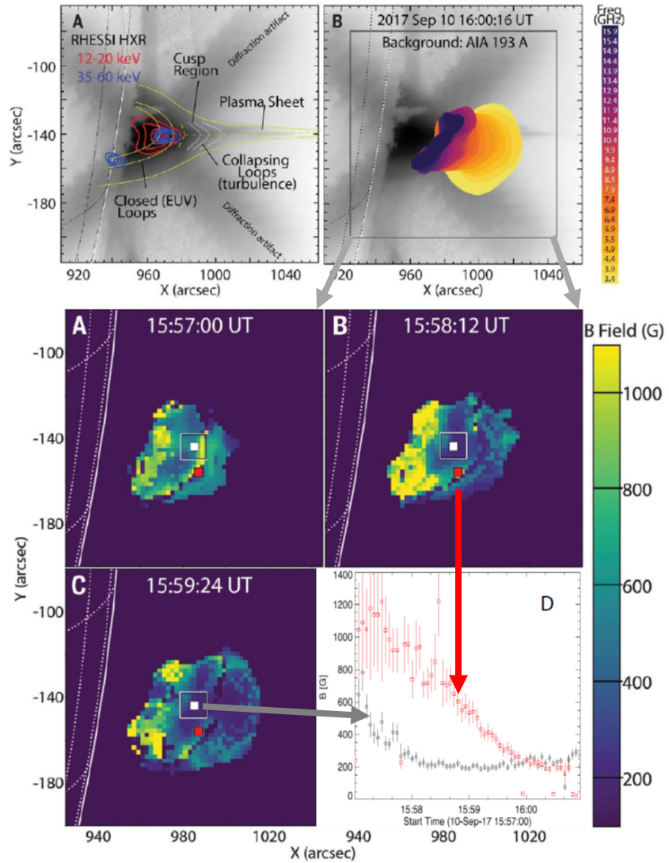 Top: multiwavelength observations including the EOVSA microwave data of the 2017-Sep-10 flare with an outline of morphological ingredients of the solar flare.<br />Bottom: three snapshots of evolving magnetic field maps (A-C) and two examples of decaying magnetic field (D) at two locations indicated in panels A-C as red and white squares. Solar flares are powered by a rapid release of magnetic energy in the solar corona. When, where, how, and with what rate the magnetic reconnection takes place to drive the solar flare remain biggest unknowns despite decades of intensive observational and theoretical studies. Direct quantitative measurements of the evolving magnetic field strength are required to clarify these questions, but such measurements have been lacking. Only most recently, with the novel methodology of microwave imaging spectroscopy, the first ever detailed spatially resolved measurements of evolving magnetic field and directly accelerated nonthermal electron population have been performed in a solar flare. They both confirmed some facets of a standard picture of solar flares and revealed entirely new, apparently unexpected features. With a new study published in Science, Dr. Gregory Fleishman of the New Jersey Institute of Technology (NJIT) and his colleagues used multi-frequency microwave imaging observations, provided by the Expanded Owens Valley Solar Array (EOVSA; a 13-element antenna array operated by NJIT), to obtain measurements of the evolving magnetic field in the flare cusp region (Figure 1) of a solar flare, showing spatial and temporal changes in the coronal magnetic field. The field decays at a rate of ~5 Gauss per second for 2 minutes, as measured within a flare subvolume of ~1028 cubic centimeters. This fast rate of decay implies a sufficiently strong electric field to account for the particle acceleration that produces the microwave emission. The decrease in stored magnetic energy is enough to power the solar flare, including the associated eruption, particle acceleration, and plasma heating.
Top: multiwavelength observations including the EOVSA microwave data of the 2017-Sep-10 flare with an outline of morphological ingredients of the solar flare.<br />Bottom: three snapshots of evolving magnetic field maps (A-C) and two examples of decaying magnetic field (D) at two locations indicated in panels A-C as red and white squares. Solar flares are powered by a rapid release of magnetic energy in the solar corona. When, where, how, and with what rate the magnetic reconnection takes place to drive the solar flare remain biggest unknowns despite decades of intensive observational and theoretical studies. Direct quantitative measurements of the evolving magnetic field strength are required to clarify these questions, but such measurements have been lacking. Only most recently, with the novel methodology of microwave imaging spectroscopy, the first ever detailed spatially resolved measurements of evolving magnetic field and directly accelerated nonthermal electron population have been performed in a solar flare. They both confirmed some facets of a standard picture of solar flares and revealed entirely new, apparently unexpected features. With a new study published in Science, Dr. Gregory Fleishman of the New Jersey Institute of Technology (NJIT) and his colleagues used multi-frequency microwave imaging observations, provided by the Expanded Owens Valley Solar Array (EOVSA; a 13-element antenna array operated by NJIT), to obtain measurements of the evolving magnetic field in the flare cusp region (Figure 1) of a solar flare, showing spatial and temporal changes in the coronal magnetic field. The field decays at a rate of ~5 Gauss per second for 2 minutes, as measured within a flare subvolume of ~1028 cubic centimeters. This fast rate of decay implies a sufficiently strong electric field to account for the particle acceleration that produces the microwave emission. The decrease in stored magnetic energy is enough to power the solar flare, including the associated eruption, particle acceleration, and plasma heating.
The need for a non-classical, fast release of the magnetic energy to drive the solar flare was recognized in early 1960s as the classical (Spitzer) dissipation of the magnetic energy is orders of magnitudes slower than observed in flares. Most of available models including PIC simulations favor the characteristic reconnection time τrec to be about τrec ~ 10 L/vA, where L is the characteristic scale of the system, vA is the Alfven speed. A strong disconnect between this modeling and the observations is that neither L nor vA can be measured at the flare energy release site. Moreover, even the very location where the main energy release takes place has not been known from observations because of the lack of reliable coronal probing. The ability to make the needed coronal measurements has appeared only recently due to the microwave imaging spectroscopy technique. The initial study published in this Science paper revealed that the main flare energy release takes place in the cusp region (Figure 1) rather than in the X-point as implied by the standard solar flare model. This finding needs to be evaluated in many more well-observed events.
Reference
“Decay of the coronal magnetic field can release sufficient energy to power a solar flare”, by Gregory D. Fleishman, Dale E. Gary, Bin Chen, Natsuha Kuroda, Sijie Yu, and Gelu M. Nita, Science, 2020. https://science.sciencemag.org/content/367/6475/278/tab-pdf
